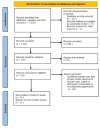Hyperbilirubinemia as a Marker for Complicated Acute Appendicitis: A Systematic Review
- PMID: 41141184
- PMCID: PMC12553480
- DOI: 10.7759/cureus.93197
Hyperbilirubinemia as a Marker for Complicated Acute Appendicitis: A Systematic Review
Abstract
Acute appendicitis (AA) is one of the most common causes of acute abdomen requiring urgent surgical intervention, and early recognition of complicated forms, such as perforation or gangrene, is crucial to reducing mortality and complications. In recent years, bilirubin has gained attention as a potential biomarker of disease severity. The aim of this systematic literature review was to evaluate the diagnostic usefulness of total bilirubin concentration as a marker of complications in AA, with particular emphasis on perforation, and to analyze its effectiveness in differentiating uncomplicated and complicated forms. A systematic search of PubMed, ScienceDirect, and Google Scholar was performed to identify studies exploring the relationship between bilirubin levels and the severity of AA. The literature indicates a correlation between hyperbilirubinemia and perforated appendicitis. Bilirubin has higher diagnostic specificity compared to classical inflammatory markers such as leukocytosis or C-reactive protein (CRP), especially when combined with clinical assessment and imaging studies. Both retrospective and prospective studies suggest that elevated bilirubin significantly increases the risk of complicated disease. Based on the evidence synthesized in this review, hyperbilirubinemia appears to be associated with complicated forms of AA, particularly perforation. While it demonstrates higher specificity than classical inflammatory markers, the available studies emphasize that it should not be used as a stand-alone diagnostic marker. Instead, bilirubin may be considered a supportive parameter, particularly when interpreted together with clinical evaluation and imaging findings.
Keywords: acute appendicitis; bilirubin concentration; diagnostic biomarker; hyperbilirubinemia; perforated appendicitis.
Copyright © 2025, Czyszczon et al.
Conflict of interest statement
Conflicts of interest: In compliance with the ICMJE uniform disclosure form, all authors declare the following: Payment/services info: All authors have declared that no financial support was received from any organization for the submitted work. Financial relationships: All authors have declared that they have no financial relationships at present or within the previous three years with any organizations that might have an interest in the submitted work. Other relationships: All authors have declared that there are no other relationships or activities that could appear to have influenced the submitted work.
Figures
References
-
- Association between acute appendicitis and hyperbilirubinemia. Hassan N, Batool W, Hassan M, Niaz MA. Insights J Health Res. 2024
-
- Hyperbilirubinemia and acute appendicitis: a cohort study. Bartimeus H, Labeda I, Uwuratuw J, Hendarto J, Prihantono P, Kusuma M, Faruk M. Minerva Med. 2025
-
- Diagnosis of acute appendicitis. Petroianu A. Int J Surg. 2012;10:115–119. - PubMed
-
- Hyperbilirubinemia and CRP as a predictor of appendiceal gangrene or perforation- a prospective study. Sreedevi S, Meera SS, Kannan P, Dhanashree BV. https://academicmed.org/Uploads/Volume7Issue1/143.%20[4687.%20JAMP_Moham... J Appl Math Physics. 2025:728–733.
Publication types
LinkOut - more resources
Full Text Sources
Research Materials
Miscellaneous

